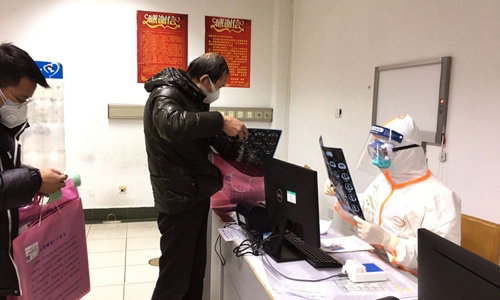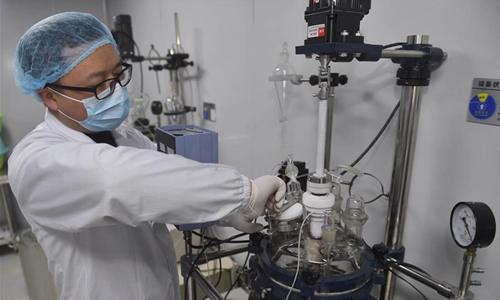In fierce anger, Zhu Chunxia sat on the sidewalk in the rain, waiting for the car to be picked up at the nCoV treatment facility. But the car never came.
Zhun, who lives in Wuhan City, was not accepted by the medical facility because of a virus-negative test result, though the doctor insisted she was infected.

Medical staff examines X-ray film for patients at Tongji Hospital, Wuhan, Hubei Province Photo: WSJ.
"They said I did not qualify. What they needed was a positive result for the virus," said Zhu, 36, a woman with two daughters.
In Wuhan, the capital of Hubei province and the pneumonia epidemic, doubts about the accuracy of the test kit used by health facilities to diagnose Covid-19 pneumonia are increasing. Global health experts also expressed concern that the number of cases could be larger than the Chinese government's statistics, due to gaps in the testing process. Many experts also warn that tens of thousands of Wuhan people may have been infected with Covid-19, while figures released by the city government were less than 20,000 at the time.
Only one in 19 corona virus infections in Wuhan has been tested and confirmed, according to estimates from the Imperial College London, UK, on January 31.
There are likely to be many undiagnosed and untreated corona virus infections. That has led many doctors and epidemiologists to call on Chinese hospitals to use a chest scan to make a diagnosis, rather than relying solely on testing samples. Many experts believe that, for patients with infections in the lower lung, it is difficult to identify. Secretary of the Party Committee of Hubei Ma Quoc Cuong was skeptical of the swab test method (using a sample specimen on the surface) during a press conference on 10 February and called on people with negative results to check again.
"To be sure the virus is negative, people should have another test one day later," said Ma Quoc Cuong.
China's National Health Agency said last week that a thoracic scan could be used to diagnose cases in the vicinity of Wuhan in Hubei province. However, officials are only considering receiving positive cases for the virus and that requires a nucleic acid test. Because of the limited number of beds, officials often prefer patients with positive test results and doctors continue to order such tests.
Nucleic acid testing, using a cotton swab to take nose mucus or phlegm, is widely used in China to diagnose corona virus, because it takes no time and can be performed by a medical staff. common medical practice as a nurse. However, doctors insisted that poor technique could lead to false results.
"The staff who took the samples were not really qualified. Not all of them were professionally trained," an unnamed doctor at the hospital in Wuhan said.
A false-negative result is a concern for researchers seeking to prevent viruses as well as common people who want to test for infection. Currently, these two groups are dependent on official data provided by the government.
Chinese hospitals currently focus more on patients who are identified with nCoV than on those who have not been diagnosed. Unrecognized, these people have to return home, the disease is getting worse and can infect others. Some go back to health facilities for more tests that increase the risk of getting the virus.
Besides, financial burden is also a problem that many people infected with the virus do not get tested. Wang Hongyan's husband contracted a lung infection despite a virus-negative test. She said the family had to pay more than 10,000 yuan (more than $ 1,400) for medical care and could not receive benefits for nCoV-infected patients.
"There are so many false-negative test results. Go to the hospital and you'll see about 90% of people there have similar results," Wang said.
In Wuhan, locals really doubt the official data released by the city when witnessing an overloaded hospital system, many of which have to find a way to overcome illnesses at home. The American Wall Street Journal looked at six patients in Wuhan who had clear symptoms of nCoV infection, but the test turned negative. Some give a positive result after the next few tests.
When Weng Wanjin, 57, fell into a coma, Ms. Hu Lihua hurriedly sought a man to take her husband to the hospital. Chest scans showed that he had acute pneumonia, but the test results did not detect nCoV.

Staff produced nucleic acid test kit in Sichuan province this week Photo: Zuma Press.
"When we received the first test result, the doctor said it could not be so," Hu said, adding that the doctor advised them to have a second test. Two days later, on February 7, the results were in line with what the doctor suspected.
Not only Ms. Hu's family, many people also encounter similar situations. Wan Pei, a telecommunications worker, had to isolate the 54-year-old mother at the hotel at the request of local authorities. Wan's mother was not hospitalized because her nasal fluid test results did not test positive for the virus. The results were similar with two subsequent phlegm sputum tests. Until the chest X-ray result on January 30 showed that both sides of her lungs were infected, the hospital said it was "right with the symptoms of viral pneumonia".
Many doctors say that, even if done correctly, testing for phlegm with a swab may not be accurate enough. Because it is only designed to detect upper respiratory tract infections. For the lower respiratory tract, if you want to detect infection, it is necessary to put an endoscope into the lungs. This is a more invasive specialized process so it is difficult for Wuhan Hospital to perform on a large scale.
"The more deeply we go into the lungs, the more accurate the results are. But we can't do it," said Peng Zhiyong, a doctor at Wuhan Center Hospital. Dr. Peng added that only 30% of patients can test positive for the virus with the upper respiratory test.
According to the WSJ, many patients who are negative for nucleic acid testing are diagnosed with a viral infection in the lower lung.
It is not known whether the new virus tends to enter the lower lung more, similar to acute respiratory distress syndrome SARS. John M. Nicholls, a pathologist at the University of Hong Kong who is working with his team to find an answer to this problem, said the current outbreak would be more difficult to control if the above assumption is correct.
"Damage from an outbreak could be more serious if the virus actually causes an infection of the lower respiratory tract, leading to a higher death rate," Nicholls said.
According to many doctors and experts, the quality of the test kit can also affect results and call for increased control of the issue. Due to the huge need for medical supplies to cope with the outbreak of pneumonia, many kits were quickly censored in just a few days.
Nearly 100 companies in China have developed corona virus test kits, according to local media. In particular, Guangdong-based medical diagnostic firm Hybribio told Chaozhou Daily that donate 3,000 unlicensed tests to local health officials.
"Due to the urgent situation, these products have not yet been registered," said Hybribio director Li Liejun. Therefore, many experts say many of the test results are not really reliable.
Meanwhile, Zhun went to see the doctor after having a fever and a severe cough. X-ray images of the chest on February 2 showed that both sides of her lungs were infected and the doctor advised a virus diagnostic test.
"The doctor said 99% I was infected," Zhu said. The test is done two days later with a negative result. While her husband, Yu Xiang, who had milder symptoms, gave a positive result. Yu was hospitalized for treatment. After sending his daughter to his relative's home, Zhu continued to stay home waiting for the second test result.
The Hubei Provincial Health Committee has said it has changed the method for calculating the case from today, bringing the virus-diagnosed cases into the new case data. This means that patients who are diagnosed based on a symptom consistent with Covid-19 are confirmed, do not necessarily have the same lab test results as before. The provincial health committee said the changes were made to match reports from other provinces across China.



 MahaliaWaitere
MahaliaWaitere







